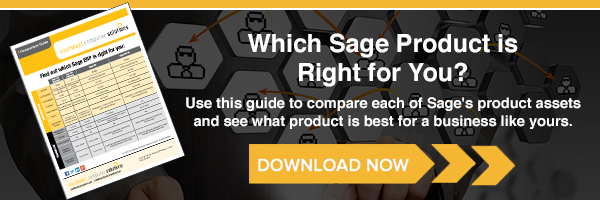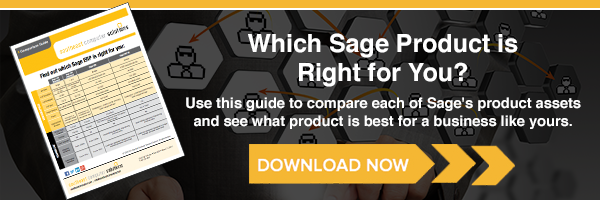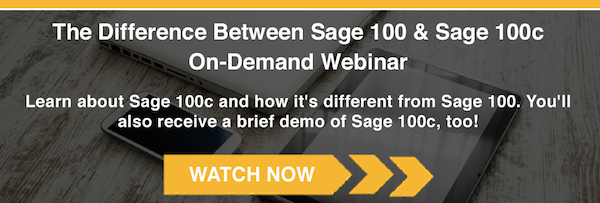 Outgrowing Sage 50 (formerly Peachtree)? 7 Differences with Sage 50 and Sage 100c
Outgrowing Sage 50 (formerly Peachtree)? 7 Differences with Sage 50 and Sage 100c
If you are outgrowing Sage 50 because it no longer meets the requirements of your growing business, wh hope this article is helpful. Here are some benefits you will receive when you upgrade to Sage 100c. There are many differences between Sage 50 and Sage 100c. In fact, the two are so different that you can only make a meaningful comparison based on your business goals, not feature/function specifics. There's additional reading in another related article, Why Upgrade to Sage 100c when Outgrowing Sage 50?
When it comes to comparing Sage 50 and Sage 100c, the question to ask is, “Do you simply need basic accounting and inventory management in a single location or do you need an intelligent informational and operational flow across your entire company and supply chain partners?”
Sage 50 is Accounting Software with Limited Capabilities and Sage 100c is Integrated Business Management Platform for Distribution and Manufacturing
- Sage 50 provides easy-to-use accounting software straight out of the box. Over the years, Sage 50 has incorporated many accounting functionalities and even provides approximately 100 reports to summarize your financials. Add reasonably robust inventory management functionality, and Sage 50 is ideal for startups or small businesses with a single office location where desktop-based software is not limiting.
- Sage 100c is a full-functionality enterprise resource planning system for growing businesses. Within 100c, accounting and inventory management are just two of the many modules; others include manufacturing, business intelligence, reporting, sales and customer management, purchasing and supplier management, HR management, time and project management, and alerting – to name just a few.

7 Key Differences between Sage 50 and Sage 100c
1. Manufacturing - For manufacturers, Sage 100c represents a giant leap forward from Sage 50. 100c manages a broad range of manufacturing processes and its bill of materials tool maintains accurate reports for work orders and functions for planning and managing material requirements. When combined with Sage 100c’s materials requirement planning and work ord
er processing tools, you gain visibility and highly accurate reporting in your end-to-end manufacturing process.
2. Accounting & Finance - Sage 100c surpasses Sage 50 by providing a general ledger tool that eliminates the need to create your own accounting charts. The system’s standard charts are customizable for reporting that corresponds to your financial reporting, and special tools enable automated management of sales tax and general tax reporting as well as compliance with federal and state tax codes.
3. Business Intelligence & Reporting - While Sage 50 lacks business intelligence functionality aside from accounting and inventory, 100c gives you visibility across the entire business. With all data integrated into a single source, you can effortlessly create real-time, automated, and preformatted reports with up-to-date, accurate, and meaningful information.
4. Sales & Customer Management - Sage 100c’s CRM add-on module allows your company to profile, track, and target customers by providing access to all customer-specific data all the time. This means your sales professionals understand the context of each customer relationship, helping them make appropriate offers at ideal points in each customer’s lifecycle.
5. Purchasing & Supplier Management - As your company grows and your supply chain increases in complexity, you need 100c’s detailed record-keeping surrounding the entire purchasing process. Beyond basic price and quantity data, a single click reveals who placed the order, which discounts were applied, and the associated shipping instructions. The syste
m can even send automated purchase requests when automatically-shared inventory data reveals that minimum inventory levels for specific parts, components, or raw materials have been reached.
6. Inventory Management & Warehousing - Sage 100c's paperless office tool generates email- and fax-based orders simultaneously to multiple recipients in any location. Moreover, 100c’s ability to provide access via the internet and mobile devices means that everyone from remote employees to foreign suppliers can react to your company’s needs, even if your offices are closed.
7. Alerting - In addition to the major modules described above, 100c also offers business alerts, a module that uses your email system to notify specific personnel when a significant development requires immediate attention. The alerts are customizable to each department’s needs.
So what's the bottom line when it comes to choosing the right solution when outgrowing Sage 50? It's all about how much integraiton you need and how much distribution or manufacturing functionality you need. At Southeast Computer Solutions, we help growing businesses clarify their strategic needs every day. If you're trying to decide which solution suits your current and future needs, contact us today for a free consultation.
Sage 100c is a game changer for companies seeking true ERP that enables a business to grow around the world or just down the street. To learn more about the new capabilities of Sage 100c, contact us today.
Talk to Us About Sage Software Support
About Southeast Computer Solutions
Southeast Computer Solutions is based in Miami, Florida, and has additional operations in Mexico. For over 30 years, we have positively impacted the success of small and mid-sized businesses with effective business management implementations that improve our clients’ operations. We listen, we are accessible, and we care. Learn more by visiting our website or calling 305-556-4697.
Another version of this blog was posted on Southeast Computers’ BLOG by Jaleidy Tannenbaum on May 30,2017 - The Difference Between Sage 50 and Sage 100c
Image courtesy of freedigitalphotos.net by scottchan

 Outgrowing Sage 50 (formerly Peachtree)? 7 Differences with Sage 50 and Sage 100c
Outgrowing Sage 50 (formerly Peachtree)? 7 Differences with Sage 50 and Sage 100c

